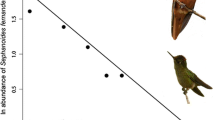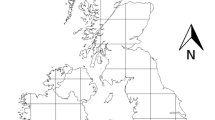Summary
This study investigates the demography and interspecific interactions of 6 Heterohyrax brucei and 4 Procavia johnstoni populations, which inhabited 6 kopjes (rock outcrops) in the Serengeti National Park, Tanzania over a period of 17 years. On three kopjes (H1, O2 and PH2) both species lived sympatrically, while on the other three (H2, H3 and P1) either one or the other species occurred allopatrically. The rainfall pattern between 1971/1972 and 1981/1982 had undergone major changes. There was significantly less precipitation in the wet season and the dry season had become extremer and longer. The kopje vegetation, recorded as percentage crown cover of browse from bushes and trees, had changed also, decreasing between 1971/72 and 1982 on 5 kopjes. In three kopjes (H1, O2 and PH2), which were shared by both hyrax species, an increase in the number of P. johnstoni, a decrease (H1 and O2) and extinction (PH2) of H. brucei took place between the time periods 1971–1976 (“good browse years”) and 1982–1984 (“poor browse years”). These changes are probably the result of indirect interspecific competition (exploitative competition) for browse material, which is the main food source for both species during the dry season. When the browsing resources are abundant coexistence on sympatric kopjes between both species is possible, but when browse is scarce the result is competitive exclusion of H. brucei by P. johnstoni. It is also argued, that P. johnstoni by being the larger species and by also being a grazer had several ecological advantages over H. brucei. In kopjes H2, H3 and P1 where H. brucei occurred allopatrically the population increased (H2, P1) or decreased (H3) during the same time period. Natural extinction was observed in kopje P1 in the allopatrically living P. johnstoni group through mange. Dispersal of 7 females and 7 males H. brucei as well as 1 female and 4 male P. johnstoni were recorded in kopjes H1, H2 and P1. One female H. brucei that immigrated successfully into kopje H2 reached an age of over 11 years. One H. brucei family group (H2) shifted its birth season from December–January to May–August. Successful natural colonization was recorded for H. brucei in kopje P1 and for P. johnstoni in H1. Two kopjes (PH2 and H3), which had no hyrax and are located far away from other hyrax populations, were experimentally colonized in 1971 and 1972 respectively. The P. Johnstoni on PH2 and the H. brucei group on H3 had been under breeding isolation for 16 years. Under such conditions P. johnstoni males can reach an age of over 8.5 years. These long-term observations have shown that the occupancy of the kopjes by both species is a dynamic process depending on the combination of several abiotic (rainfall and availability of holes and hiding places) and biotic factors (interspecific and intraspecific competition for food, interspecific cooperation, predation and parasites) as well as the degree of inbreeding dependent on the geographic isolation of the kopje.
Similar content being viewed by others
References
Belovsky GE (1986) Generalist herbivore foraging and its role in competitive interactions. Am Zool 26:51–69
Grown JH, Maurer BA (1986) Body size, ecological dominance and Cope's rule. Nature (London) 324:248–250
Caro TM, Alawi RM (1985) Comparative aspects of behavioural development in two species of free-living hyrax. Behaviour 95:87–109
Chesson PL, Case TJ (1985) Overview: Nonequilibrium Community Theories: Chance, Variability, History, and Coexistence. In: Diamond JM, Case TJ (eds) Community Ecology Harper & Row. pp 229–239
Connell JH (1983) On the prevalence and relative importance of interspecific competition: Evidence from field experiments. Am Nat 122:661–696
Connor RC, Norris KS (1982) Are Dolphins reciprocal altruists? Am Nat 119:358–374
DeNiro MJ, Epstein S (1978) Carbon Isotopic evidence for different feeding patterns in two hyrax species occupying the same habitat. Science 201:906–908
Dickman CR (1986) An experimental manipulation of the intensity of interspecific competition: effects on a small marsupial. Oecologia 70:536–543
Dickman CR (1988) Body size, prey size, and community structure in insectivorous mammals. Ecology 69(3):569–580
Gartlan JS, Struhsaker TT (1972) Polyspecific associations and niche separation of rainforest anthropoids in Cameroon, West Africa. J Zool 168:221–226
Grant PR (1972) Interspecific competition among rodents. Ann Rev Ecol Syst 3:79–106
Grant PR (1978) Dispersal in relation to carrying capacity. Proc Natl Acad Sci USA 75:2854–2858
Greenwood PJ (1980) Mating systems, philopatry and dispersal in birds and mammals. Anim Behav 28:1140–1162
Hoeck HN (1975) Differential feeding behaviour of the sympatric hyrax Procavia johnstoni and Heterohyrax brucei. Oecologia 22:15–47
Hoeck HN (1978a) Systematics of the Hyracoidea: towards a clarification. In ecology and taxonomy of African small mammals. Bull Carnegie Mus Nat Hist, Pittsburgh 6:146–151
Hoeck HN (1978b) Heterohyrax brucei (Procaviidae) young playing with each other and with young Procavia johnstoni. Film E2473 of the Inst Wiss Film, Göttingen 1978. Publ. by HN Hoeck, Publ Wiss Film Sek Biol Ser 11, No 29/E2473. 8S
Hoeck HN (1982) Population dynamics, dispersal and genetic isolation in two species of Hyrax (Heterohyrax brucei and Procavia johnstoni) on habitat islands in the Serengeti. Z Tierpsych 59:177–210
Hoeck HN, Klein H, Hoeck P (1982) Flexible social organization in Hyrax. Z Tierpsych 59:265–298
Jarman P (1974) The social organization of antelope in relation to their ecology. Behaviour 48:215–266
Levine SH (1976) Competitive interactions in ecosystems. Am Nat 110:903–910
Mac Arthur RH, Wilson EO (1967) Island Biogeography. Monographs in Population Biology 1. Princeton: University Press
McNab BK (1980) Food habits energetics and the population biology of mammals. Am Nat 116:106–124
McNaughton SJ (1985) Ecology of a grazing ecosystem: the Serengeti. Ecol Monogr 55:259–294
May RM (1988) How many species are there on earth? Science 241:1441–1449
May RM, Seger J (1986) Ideas in Ecology. Am Sci 74:256–267
Moore J, Ali R (1984) Are dispersal and inbreeding avoidance related? Anim Behav 32:94–112
Norton-Griffiths M, Herlocker D, Pennycuick L (1975) The patterns of rainfall in the Serengeti Ecosystem, Tanzania. E Afr Wildl J 13:347–374
Partridge L, Harvey PH (1988) The ecological context of life history evolution. Science 241:1449–1455
Pulliam HR (1986) Niche expansion and contraction in a variable environment. Am Zool 26:71–79
Ricklefs RE (1987) Community diversity: Relative roles of local and regional processes. Science 235:167–171
Roughgarden J (1983) Competition and theory in community ecology. Am Nat 122:583–601
Schoener TW (1983) Field experiments on interspecific competition. Am Nat 122:240–285
Schoener TW (1986) Mechanistic approaches to community ecology: a new reductionism? Am Zool 26:81–106
Sinclair ARE (1979) The Serengeti Environment. In: Serengeti. Dynamics of an Ecosystem, 2:31–45. Sinclair, ARE, Norton-Griffiths M (eds) Chicago: University Press 2:31–45
Sinclair ARE, Norton-Griffiths M (1979) Serengeti. Dynamics of an Ecosystem. Chicago: University Press
Terborgh J (1983) Five new World primates. A study in comparative ecology. Monographs in Behavior and Ecology. Princeton: University Press
Tilman D (1987) The importance of the mechanisms of interspecific competition. Am Nat 129:769–774
Vesey-FitzGerald DF (1960) Grazing succession among East African game animals. J Mamm 41:161–172
Walker A, Hoeck HN, Perez L (1978) Microwear of mammalian teeth as an indicator of diet. Science 201:908–910
Waser PM (1985) Does competition drive dispersal? Ecology 66:1170–1175
Widdowson EM (1976) The responses of the sexes to nutritional stress. Proc Nutr Soc 35:175–180
Wiens JA (1977) On competition and variable environments. Am Sci 65:590–597
Author information
Authors and Affiliations
Additional information
SWRC publication No. 448
Rights and permissions
About this article
Cite this article
Hoeck, H.N. Demography and competition in Hyrax. Oecologia 79, 353–360 (1989). https://doi.org/10.1007/BF00384314
Received:
Published:
Issue Date:
DOI: https://doi.org/10.1007/BF00384314




